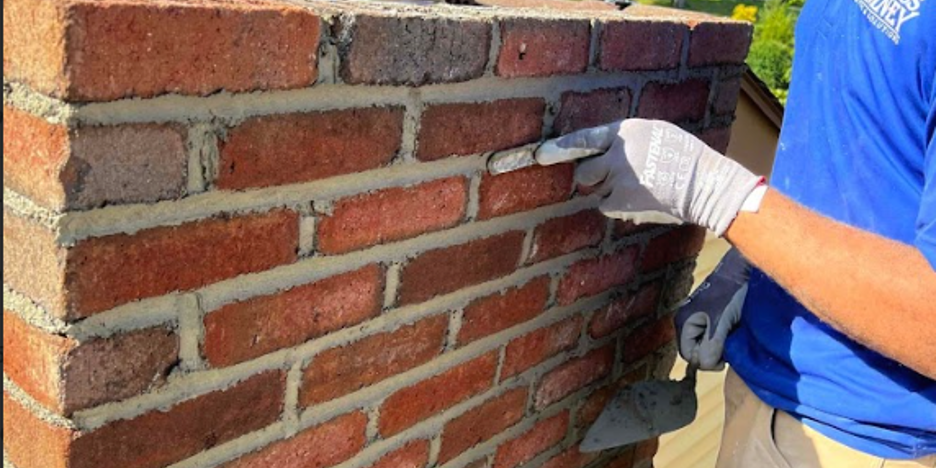What is a Chimney Repoint?
As you are looking at your chimney, you may notice that the grey-ish mortar in between the bricks or stones is missing chunks or otherwise deteriorating. The breakdown of these mortar joints is not just an aesthetic problem but also a structural one. A few worn spots in your chimney may not seem like a big deal now, especially if your chimney system appears to be functioning as usual. However, completing chimney repairs early on may help prevent long-term consequences and greater costs in the future. Here, learn more about why chimney repointing may be the necessary solution to these chimney concerns.
Repointing a Chimney
Well-constructed chimneys are designed to endure interior and exterior conditions. However, especially over time, they may begin to break down. Cracked or flaking mortar often results from wear and tear due to age, weather, and movement of the home. If mortar problems aren’t fixed, more issues often arise such as damage to surrounding chimney material or water impacting the chimney system.
If you suspect or see damage of any size to your chimney, it’s time to call the chimney expert near you. In doing so, fixing an issue like the crumbling mortar between the chimney bricks may require repointing a chimney instead of rebuilding it. Although it may subtly improve the look of the chimney, the primary purpose of chimney repointing is to strengthen the structure of the chimney by removing the old or deteriorating mortar and replacing it with new mortar. This process helps reinforce the chimney against water damage and support its longevity.
Signs of a Potential Chimney Repoint
In addition to cracks in the mortar or broken bits of it, changes in the mortar color may also indicate a problem. If the cracks or damage to the mortar have become more extensive, water is likely to seep into the chimney system, resulting in damage to your home’s interior walls or rust on your fireplace components. It may be hard to spot chimney wear as it is happening. While you may be able to see the base of your home’s chimney, viewing the upper portions may be more challenging.
Consequently, routine chimney inspections are the best way to ensure the safety and integrity of your chimney and speedy solutions to any problems that may arise. By pairing a Level 2 inspection with a chimney cleaning, as offered at Spotless Chimney, homeowners check multiple items off of their chimney care checklist in a single service and receive a full digital inspection report to help them keep track of their chimney needs. Additionally, chimney specialists will be able to determine if repointing will resolve your chimney issues or if more substantial repairs are needed. For example, in more severe cases where brick or stones are also crumbling, the mortar damage is more significant, or additional chimney system features are compromised, a partial or full chimney rebuild may be needed.
Frequently Asked Questions about Chimney Repointing
What is a chimney repoint?
Chimney repointing is the process of removing damaged or deteriorating mortar between bricks and replacing it with fresh mortar to restore the chimney’s structural integrity and prevent water infiltration. It’s a vital maintenance step that helps extend the life of your chimney and protects your home from costly damage.
Can I do a chimney repoint myself?
Even though the crack may seem small or the crumbling may be isolated, DIY chimney repointing isn’t advisable. Aside from the necessary skills and specialty tools, not to mention height and safety considerations, incorrect completion may cause greater problems for your chimney. Especially for homeowners considering property value in relation to home improvement efforts, professional care better helps ensure that you maintain the more than 10% higher listings associated with homes for sale with fireplaces, according to Redfin.
Is repointing a chimney necessary if the fireplace isn’t in use?
In addition to the consideration of your home’s overall property value, repointing a chimney is also about maintaining the safety of your home. As with DIY chimney work, putting off chimney maintenance may have consequences in the future. For example, water damage may impact the home via the chimney, or the chimney itself may start to become a danger.
What’s the difference between repointing and tuckpointing?
Since both terms involve the mortar between bricks, stones or other chimney materials, they may sometimes be used interchangeably. While repointing a chimney focuses on structural integrity, tuckpointing is typically used for specific aesthetic improvements to do with mortar color.
For chimney repoints and many other chimney-related services, Spotless Chimney is a locally-owned and operated company that serves all of Connecticut. In addition to the details provided in our service descriptions, please visit our portfolio to explore our work quality. We also welcome you to contact us with additional questions today!







